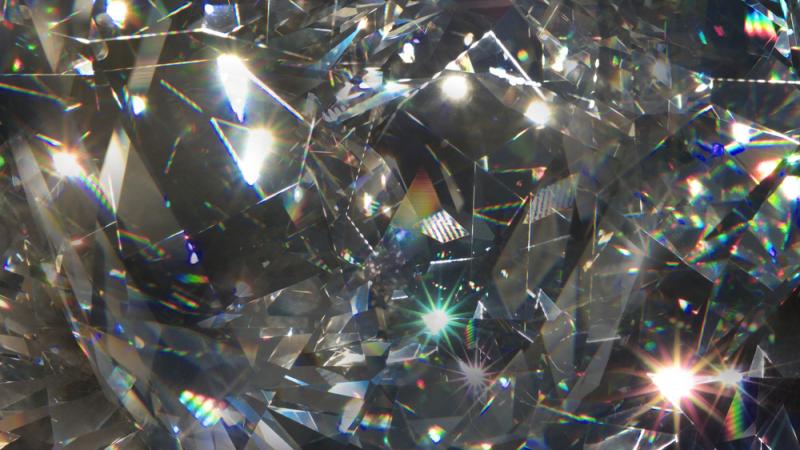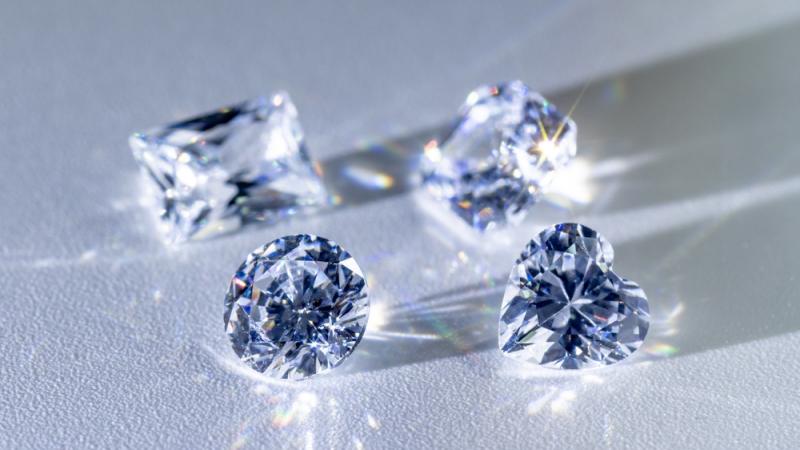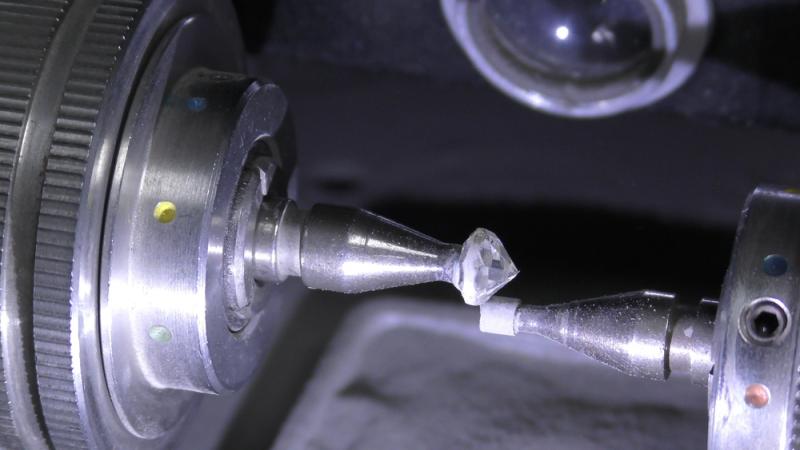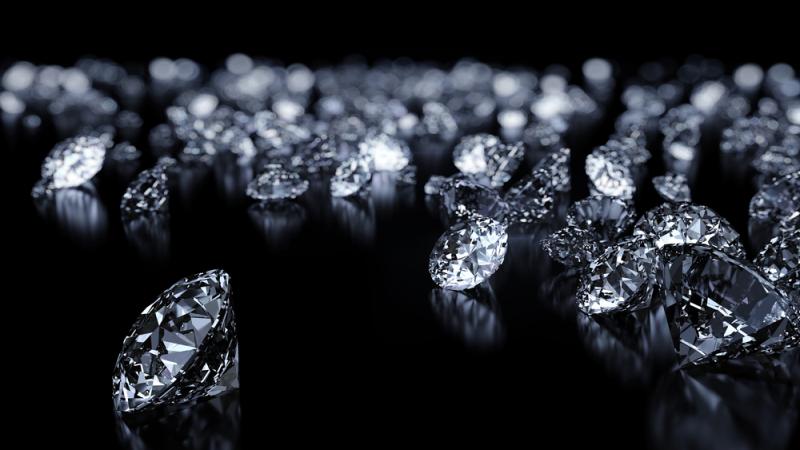You’ve likely come across discussions about diamond quality and the 4C’s that define it. Among these, the cut is considered the most crucial as it influences other aspects. But how does diamond symmetry relate to this?
What exactly does diamond symmetry mean, and does it depend on the gem’s internal structure? Prepare to be surprised as we delve into the answers to these questions and more, harmoniously aligned for your understanding!
DESIGN YOUR OWN ENGAGEMENT RING: START WITH A SETTING OR START WITH A DIAMOND. IT’S REALLY UP TO YOU!

Diamonds: Internal Structure
Diamond symmetry is often discussed in relation to modeling the facets of a diamond. However, it would be meaningless if the internal structure of the diamond didn’t possess a certain degree of symmetry as well.
To create a lustrous diamond, all that is required is a thread of light. This light interacts with the diamond’s internal planes in three ways:
- Brilliance: This is considered the most important aspect, involving the direction of white light rays as they enter the stone. The goal is for the light to enter from any angle and exit swiftly at the top of the diamond, within the viewer’s line of sight.
- Fire: Diamonds exhibit exceptional “fire” by dispersing light into various colored wavelengths. This occurs when white light bounces off the diamond’s inner planes multiple times, resulting in a display of separated colors that reach the viewer’s eyes.
- Scintillation: Often overlooked by the general public, scintillation plays a significant role in a diamond’s sparkle. It refers to the flashes of light that appear when the diamond, the viewer, or the light source is in motion. These flashes can be either white or colored, adding to the overall beauty of the gem.
While the cut of the diamond influences these light phenomena, it wouldn’t be possible without the carbon atoms that make up the diamond both internally and externally. These carbon atoms interact with the photons of light, creating the desired optical effects.
The internal structure of a diamond is formed by carbon atoms arranged in a crystalline lattice. The lattice consists of repeated unit cells, which define the overall appearance of the diamond. X-ray diffraction reveals the vectors of the carbon unit cells, highlighting the unique internal symmetry of each diamond. This structural uniqueness is why no two diamonds are exactly alike.
The carbon atoms within the diamond are arranged tetrahedrally, with each atom covalently bonded to four others. This arrangement creates a rigid and infinite network, resulting in the diamond’s remarkable hardness. Diamonds rank a perfect 10 on the Mohs scale of hardness and can scratch any other material.
Diamonds possess exceptional durability, resistance to compression, excellent heat conductivity, sound conduction, optical transparency, and chemical inertness. However, they can still be susceptible to damage, especially if there are inclusions or internal strains present. Inclusions are natural imperfections within the diamond, while diamond strains are built-up pressures formed during the diamond’s creation. Care must be taken to prevent chips or fractures in diamonds.
For further information on safeguarding your diamonds, refer to our comprehensive article discussing important aspects of diamond protection.

What Is Diamond Symmetry?
Now that you have gained insight into the internal symmetry of diamonds, let’s shift our focus to the surface of the gem.
You may already know that a diamond’s surface is composed of planes called facets. These facets are not naturally present in the gemstone; they are meticulously created by skilled diamond cutters. Through cutting, the light rays are directed in a way that maximizes the play of light within the diamond. This process can be carried out either by hand or using advanced machinery, allowing for the creation of various exotic diamond shapes.
Speaking of diamond cuts, it’s worth noting that round brilliant diamonds stand out as the pinnacle of perfectly optimized and sparkling shapes.
Cutting and polishing are the final stages in the diamond sculpting process, and the Gemological Institute of America (GIA) pays close attention to specific diamond features during these steps, examining them under 10x magnification. Symmetry plays a crucial role in this evaluation. While many people associate symmetry with shape, it actually refers to how well the facets of a diamond align with each other. The degree of symmetry impacts the diamond’s grade and price.
Any visible flaws in facet positioning and shape must be documented, often seen as cumulative deviations rather than isolated imperfections. When shopping for a diamond, you may encounter several typical symmetry flaws, including:
- Extra Facet (EF): An additional facet that has been added.
- Misalignment (Aln): Displacement of crown and pavilion facets.
- Table/Culet Alignment (T/C): Misalignment between the culet and table.
- Natural (N): An untreated part of the original diamond surface.
- Out-of-Round (OR): Deviations from the circular shape.
- Pavilion Angle Variation (PV): Unequal pavilion angles.
- Table Off-Center (T/oc): Deviation of the table.
- Uneven Outline (UO): Bumps, flattened spots, or uneven girdle faceting.
There are many more symmetry features that may be listed on a diamond certificate, if applicable.
Diamond polishing is just as important as the cutting process itself. It enhances the desired light display by providing a smooth and glass-like finish on the diamond’s surface. In the past, polishing was commonly done using wheels and diamond dust. However, it has been discovered that such mechanical methods often result in subsurface damage and limit the achievable surface finish of the stone.
To address these shortcomings, researchers are exploring new physical and chemical approaches to polishing. The GIA has identified various polishing features that may be observed on a diamond, including:
- Nick (Nck): A notch on a facet junction.
- Lizard skin (LS): Uneven texture on a single facet.
- Pit (Pit): A small hole appearing as a white dot.
- Burn (Brn/Dop): Whitish haze caused by heat.
- Abrasion (Abr): Scratches and pits that create fuzzy facet junctions instead of sharp lines.
These features are referred to as polishing features, and their location is often specified, as they can appear on any part of the gemstone. As no single method fulfills all the requirements for a perfect polish, re-polishing is sometimes employed, particularly for vintage diamond pieces such as old single, Peruzzi, and rose-shaped diamonds.

Symmetry Or Polish: What’s More Important?
When a diamond is cut asymmetrically, it can result in light rays moving in unfavorable directions, leading to a lackluster appearance. As the cut significantly influences the other 4 C’s, poor symmetry can have a noticeable impact on the overall quality of the diamond.
However, it’s important to note that artisans cannot be solely blamed for asymmetry since diamonds occur naturally with their own inherent characteristics. On the other hand, the polishing process has a more direct effect on the gemstone, and any imperfections are often difficult to detect with the naked eye. Therefore, if you have to choose between symmetry and polish when shopping for a diamond, prioritize the quality of the diamond’s polish.
Nevertheless, both symmetry and polish are integral in determining the brilliance of the stone, which is why they are usually evaluated and graded together.
The reputable grading system used by the Gemological Institute of America (GIA) for symmetry and polish combined follows this scale:
- Excellent: Facets are perfectly sized and proportioned.
- Very Good: One or two elements show slight disproportion.
- Good: Size or location of facets exhibits some disproportion, affecting sparkle.
- Fair: Noticeable disproportion in facet proportions significantly impacts brilliance.
- Poor: Visible disproportion in facets misdirects light rays, resulting in a loss of sparkle and brilliance.
Gemologists state that the difference between the top two grades, Excellent and Very Good, is minimal, and both can be considered as having an excellent cut. However, if you desire perfection, consider a round brilliant diamond. It may achieve a GIA Triple Excellent grade or an AGS 000 grade, indicating an excellent/ideal cut, symmetry, and polish.
In fact, there are even super-ideal diamonds available, which can cost up to 35% more than an Excellent graded diamond. These diamonds exhibit exceptional symmetry and polish and often display a hearts-and-arrows pattern, visible as arrows from the top and hearts from the bottom. It’s worth noting that these details may not always be noticeable once the diamond is set in jewelry.
For more information about GIA certificates and other diamond details, you can find additional resources here.

Final Thoughts
Natural diamonds consist primarily of pure carbon, although trace elements can contribute to the color of their brilliance. The arrangement of these carbon atoms in a tetrahedral structure forms the internal composition of the diamond, which interacts with light to produce specific colors or the absence thereof.
However, it is the diamond symmetry that enables the utilization of these light angles and directions within its internal structure. Achieving symmetry is primarily accomplished through the cutting and arrangement of diamond facets, but it is further enhanced by the polishing process.
When both the internal and external structures of a diamond are combined harmoniously, they create the optimal conditions for the diamond to sparkle brilliantly. Therefore, it is crucial to consider both factors when purchasing a certified precious stone, as they play a significant role in its overall visual appeal and value.


